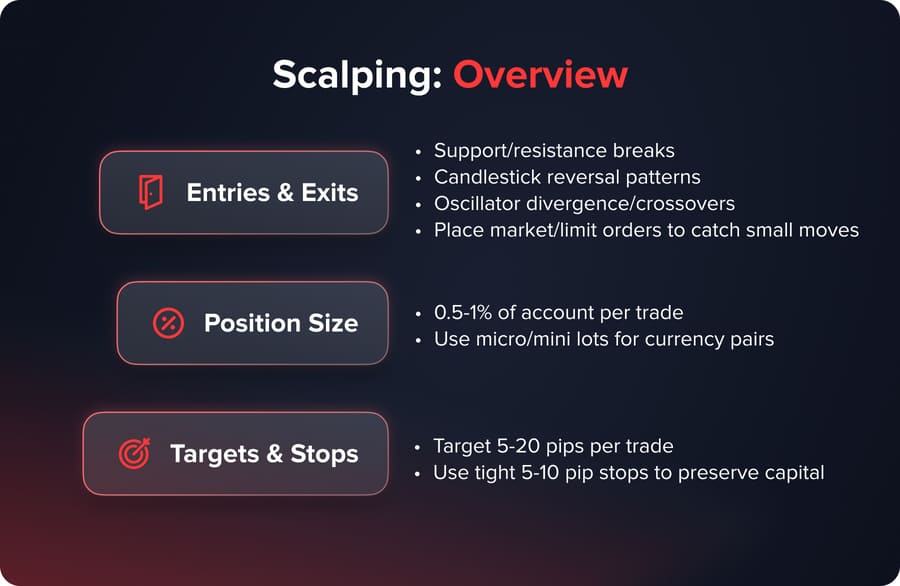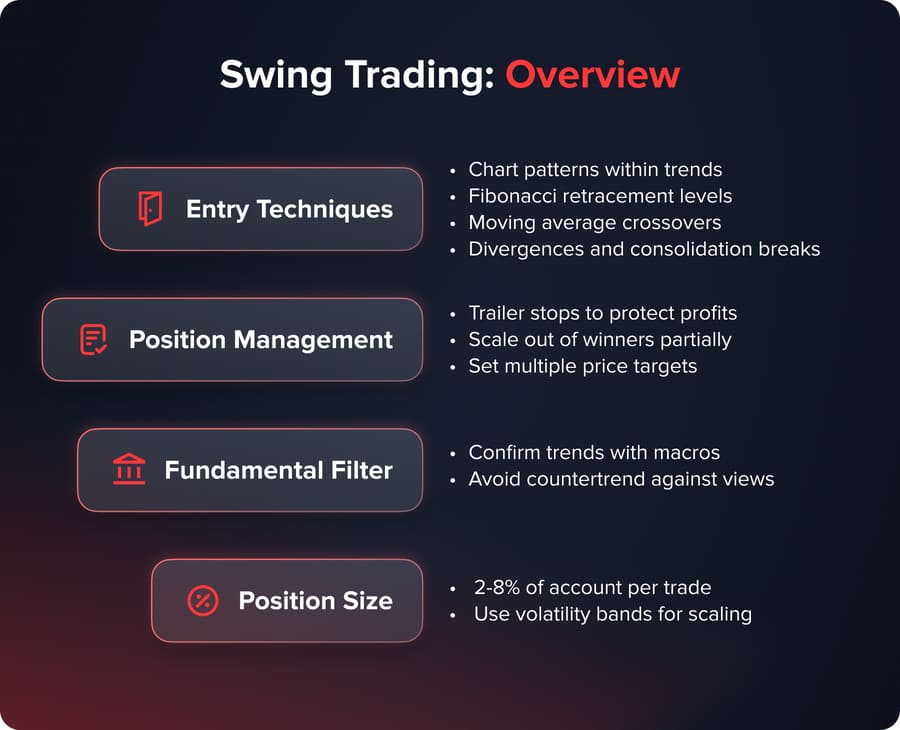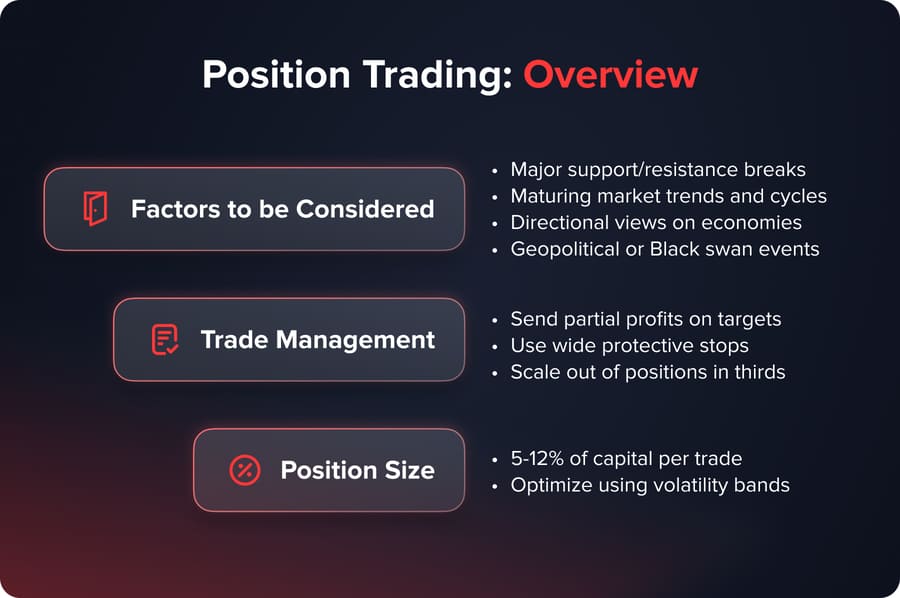
กลยุทธ์การซื้อขาย Forex ที่ดีที่สุดในปี 2024
เนื้อหา
กลยุทธ์การซื้อขาย Forex ที่ดีที่สุดในปี 2024:
- การถลกหนังหัว
- การซื้อขายรายวัน
- การซื้อขายแบบสวิง
- การซื้อขายแบบตำแหน่ง
เหตุใดกลยุทธ์การซื้อขาย Forex จึงมีความสำคัญ?
เพื่อหลีกเลี่ยงข้อผิดพลาดเหล่านี้และเพิ่มอายุการใช้งานให้ยาวนานที่สุด การทุ่มเทพลังงานอย่างรอบคอบในการพัฒนากลยุทธ์ตั้งแต่เริ่มต้นจะให้ผลตอบแทนมหาศาล ระบบที่ดีจะสร้างกรอบการทำงานที่จำเป็นต่อการตัดสินใจอย่างเป็นกลาง แม้ว่าจะมีผลขาดทุนเกิดขึ้น ซึ่งเป็นสิ่งที่หลีกเลี่ยงไม่ได้ในการซื้อขายในระยะยาว
โดยคำนึงถึงสิ่งนี้ ต่อไปนี้คือเหตุผลสำคัญบางประการว่าเหตุใดการมีกลยุทธ์ที่ชัดเจนจึงเป็นกระดูกสันหลังของธุรกิจการค้า:
- หากปราศจากกลยุทธ์ที่ชัดเจน อารมณ์ต่างๆ เช่น ความกลัวและความโลภ อาจส่งผลเสียต่อการตัดสินใจซื้อขายได้ กลยุทธ์ต่างๆ มักมีกฎเกณฑ์ที่ชัดเจนให้ปฏิบัติตาม
- การถอนเงินออกเป็นสิ่งที่หลีกเลี่ยงไม่ได้ แต่กลยุทธ์ต่างๆ จะต้องรักษาความมีวินัยไว้แม้ในช่วงที่ขาดทุนด้วยการควบคุมความเสี่ยงที่กำหนดไว้ล่วงหน้าและพารามิเตอร์การกำหนดขนาดตำแหน่ง
- กลยุทธ์ต่างๆ กำหนดกฎการเข้าและออกที่ชัดเจน ซึ่งจะล็อกการซื้อขายให้อยู่ในโซนกำไรและโซนหยุดที่สม่ำเสมอ เพื่อป้องกันการออกก่อนกำหนดอันเนื่องมาจากความผันผวน
- ผู้ค้าสามารถทดสอบย้อนหลังแนวทางกลยุทธ์ต่างๆ ได้อย่างเป็นกลางเพื่อระบุระบบที่มีความน่าจะเป็นสูงกว่าและพื้นที่สำหรับการปรับปรุงผ่านผลลัพธ์เชิงปริมาณ
- กลยุทธ์ช่วยให้เน้นไปที่โอกาสทางการค้าที่ให้ผลตอบแทนสูงซึ่งสอดคล้องกับแนวโน้มและระดับที่ได้รับการยืนยัน แทนที่จะตัดสินใจตอบสนองต่อการเคลื่อนไหวของราคาในระยะสั้น
- การปฏิบัติตามแนวทางเชิงระบบที่ได้รับการพิสูจน์แล้วว่าสามารถสร้างมูลค่าคาดหวังเชิงบวกได้ผ่านการทดสอบ ทำให้ผู้ซื้อขายมีความได้เปรียบเหนือผู้ซื้อขายตามดุลยพินิจในระยะยาว
- การจัดการความเสี่ยง การกำหนดขนาดตำแหน่ง การวางแผนการซื้อขาย และกระบวนการตรวจสอบจะถูกรวมเข้าไว้ในกรอบกลยุทธ์เพื่อปฏิบัติต่อการซื้อขายเป็นธุรกิจและเพิ่มผลกำไรในระยะยาวให้สูงสุด
การถลกหนังหัว

Scalping คือการเข้าและออกจากการซื้อขายระยะสั้นมากๆ ภายในช่วงการซื้อขายเดียวกัน โดยปกติแล้วสถานะจะถูกถือไว้เพียงไม่กี่นาที โดยมีจุดประสงค์เพื่อทำกำไรจากการเคลื่อนไหวของราคาเพียงเล็กน้อย
กลยุทธ์ Scalping ในปี 2024 ใช้กราฟระหว่างวัน เช่น กรอบเวลา 1 นาที และ 5 นาที โดยปกติแล้วการเข้าและออกจะดำเนินการเมื่อราคาทะลุแนวรับและแนวต้าน ร่วมกับตัวบ่งชี้ทางเทคนิคที่ส่งสัญญาณภาวะซื้อมากเกินไปหรือขายมากเกินไป ตัวบ่งชี้อย่าง Stochastic Oscillator และตัวบ่งชี้อื่นๆ มักแสดงการเปลี่ยนแปลงโมเมนตัมระยะสั้นที่เหมาะสมกับการ Scalping
ตำแหน่งของคุณควรคิดเป็นสัดส่วนเพียง 1% หรือน้อยกว่าของขนาดบัญชีโดยรวม เพื่อลดความเสี่ยงในการเทรด คุณสามารถทำกำไรได้เล็กน้อยบ่อยครั้ง โดยอัตราส่วนความเสี่ยงต่อผลตอบแทนอยู่ที่ 1:1 ถึง 2:1 กลยุทธ์นี้จำเป็นต้องมีการติดตามความผันผวนของตลาดอย่างต่อเนื่อง ดังนั้นจึงเหมาะกับเทรดเดอร์ที่มีเวลาและสมาธิมากในการสังเกตการเคลื่อนไหวของราคาและเทรดบ่อยๆ แม้ว่าจะต้องใช้ความพยายามอย่างมาก แต่กลยุทธ์นี้มีความเสี่ยงน้อยกว่ากลยุทธ์อื่นๆ เนื่องจากระยะเวลาการถือครองสั้นมาก
ทางเข้าและทางออก:
- การทำลายแนวรับ/แนวต้าน
- รูปแบบการกลับตัวของแท่งเทียน
- การแยกตัวของออสซิลเลเตอร์/ครอสโอเวอร์
- วางคำสั่งตลาด/จำกัดเพื่อจับการเคลื่อนไหวเล็กๆ น้อยๆ
ขนาดตำแหน่ง:
- 0.5-1% ของบัญชีต่อการซื้อขาย
- ใช้ล็อตไมโคร/มินิสำหรับคู่สกุลเงิน
เป้าหมายและการหยุด:
- เป้าหมาย 5-20 pips ต่อการซื้อขาย
- ใช้จุดหยุดที่แคบ 5-10 จุดเพื่อรักษาเงินทุน
เคล็ดลับสำหรับการ Scalping:
- ดูคู่สกุลเงิน 1-3 คู่เท่านั้น
- สร้างรายการอัตโนมัติด้วยการแจ้งเตือนตัวบ่งชี้
- หนังศีรษะไปในทิศทางแนวโน้มรายวัน
ข้อดีของการ Scalping:
- ต้องใช้เงินทุนเพียงเล็กน้อยในการเริ่มต้น
- กำไรที่สะสมบ่อยครั้งจะทวีคูณขึ้นตามกาลเวลา
- เรียนรู้การเคลื่อนไหวของราคาได้ง่าย
ข้อเสียของการ Scalping:
- ต้องใช้เวลาอยู่หน้าจออย่างต่อเนื่อง
- ความเครียดสูงจากการซื้อขายรายวันจำนวนมาก
- ง่ายต่อการซื้อขายเกินสัญญาณเล็กๆ น้อยๆ
การซื้อขายรายวัน
เดย์เทรดคือการเปิดและปิดการเทรดภายในหนึ่งเซสชั่นการซื้อขาย โดยส่วนใหญ่ซื้อขายตั้งแต่ช่วงเปิดตลาดเช้าไปจนถึงช่วงบ่าย วิธีการนี้มีวัตถุประสงค์เพื่อจับความผันผวนของราคาระหว่างวัน ไม่ใช่แนวโน้มโดยรวม
ในปี 2024 เมื่อใช้กราฟรายวัน ควรมุ่งเน้นไปที่แนวรับและแนวต้าน รวมถึงการเคลื่อนไหวตามข่าวที่แสดงตัวบ่งชี้ทางเทคนิคของการเปลี่ยนแปลงราคา พยายามติดตามแนวโน้มเมื่อตลาดแข็งแกร่ง และเทรดแบบช่วงราคาเมื่อราคาปรับตัวขึ้น ควรติดตามมากกว่าหนึ่งกรอบเวลาเพื่อตรวจสอบสัญญาณการกลับตัว
เสี่ยง 1-5% ของเงินในบัญชีของคุณต่อการเทรดหนึ่งครั้ง ตั้งเป้าผลตอบแทนความเสี่ยงไว้ที่ 1:2 ถึง 1:3 เพื่อผลตอบแทนที่ดี ฝึกฝนการเทรดแบบเดย์เทรดโดยสังเกตการเคลื่อนไหวของราคาในระยะสั้น ฝึกฝนวินัยด้วยการจัดทำแผนสำหรับการเทรดแต่ละครั้งและตั้งจุดตัดขาดทุนให้แน่น เนื่องจากความผันผวนระหว่างวันสร้างความเสี่ยงมากขึ้น
รายการ:
- เส้นแนวโน้มหรือเส้น MA ทะลุ
- การย้อนกลับดึงกลับเข้าสู่โซนจุดเข้า
- สวิงเบรกสูง/ต่ำ
- สัญญาณขยายระดับเสียงสไปค์
ทางออก:
- รับกำไรที่ระดับต้านทานรายวัน
- ย้ายจุดหยุดไปที่จุดคุ้มทุนหรือล็อคกำไรเล็กน้อย
- ซื้อขายตามทิศทางของกรอบเวลาที่ใหญ่ขึ้น
ขนาดตำแหน่ง:
- 1-3% ของบัญชีต่อการซื้อขาย
- เพิ่มประสิทธิภาพโดยใช้อัตราส่วนที่ปรับตามความเสี่ยง
เหตุการณ์พื้นฐาน:
- ข่าวการค้าส่งผลต่อทิศทาง
- ใช้การหยุดการขาดทุนเพื่อป้องกันการหลอกลวง
ประโยชน์ของการซื้อขายรายวัน:
- ใช้ประโยชน์จากความผันผวนระยะสั้น
- ตารางเวลาที่ยืดหยุ่นเหมาะกับไลฟ์สไตล์ที่หลากหลาย
- ศักยภาพในการซื้อขายหลายรายการต่อวัน
ความท้าทายสำหรับเดย์เทรดเดอร์:
- ต้องใช้ความพยายามที่เน้นในแต่ละเซสชัน
- ความเครียดที่สูงขึ้นจากความผันผวนระหว่างวัน
- การซื้อขายเกินในกรอบเวลาขนาดเล็กทำได้ง่าย
การซื้อขายแบบสวิง

การเทรดแบบสวิงเทรด (Swing Trading) คือการถือครองสถานะไว้เป็นเวลาหลายวันถึงหลายสัปดาห์ในคราวเดียว กลยุทธ์ระยะกลางนี้ผสมผสานองค์ประกอบบางอย่างของเป้าหมายทั้งในระยะสั้นและระยะยาวเข้าด้วยกัน
ในปี 2024 การระบุแนวโน้มจะทำได้โดยใช้กราฟรายวันและรายสัปดาห์ นอกจากนี้ ยังจะสามารถส่งสัญญาณเข้าและออกได้อีกด้วย ระดับการย้อนกลับของ Fibonacci จะให้จุดเข้าหลังจากเกิดการย่อตัวภายในแนวโน้ม รูปแบบกราฟ รูปสามเหลี่ยม และธง เหมาะอย่างยิ่งสำหรับการซื้อขายแบบสวิง เมื่อมีเส้นค่าเฉลี่ยเคลื่อนที่หรือตัวบ่งชี้รองรับ
เสี่ยง 2-10% ของเงินทุนต่อการซื้อขาย ควรเลือกอัตราส่วนความเสี่ยงต่อผลตอบแทนที่ดีกว่า 1:3 เนื่องจากการแกว่งตัวของราคามีระยะเวลาถือครองที่นานกว่าเพื่อให้บรรลุเป้าหมาย อดทนรอและเผื่อเวลาไว้สักสองสามสัปดาห์เพื่อให้สถานะพัฒนา กลยุทธ์นี้มีความเครียดน้อยกว่าการซื้อขายรายวัน และอาจยังมีโอกาสในการซื้อขายบ้างในหนึ่งเดือน
เทคนิคการเข้าสู่ตลาด:
- รูปแบบแผนภูมิภายในแนวโน้ม
- ระดับการย้อนกลับของฟีโบนัชชี
- ค่าเฉลี่ยเคลื่อนที่แบบครอสโอเวอร์
- การแยกทางและการแตกหักของการรวมกลุ่ม
การจัดการตำแหน่ง:
- รถพ่วงหยุดเพื่อปกป้องผลกำไร
- ปรับขนาดผู้ชนะบางส่วนออก
- กำหนดเป้าหมายราคาหลายรายการ
ตัวกรองพื้นฐาน:
- ยืนยันแนวโน้มด้วยแมโคร
- หลีกเลี่ยงการสวนกระแสกับมุมมอง
ขนาดตำแหน่ง:
- 2-8% ของบัญชีต่อการซื้อขาย
- ใช้แถบความผันผวนเพื่อปรับขนาด
ประโยชน์ของการซื้อขายแบบสวิง:
- ลดความเครียดเมื่อเทียบกับการซื้อขายรายวัน
- ศักยภาพในการซื้อขายหลายรายการต่อเดือน
- ถือครองสั้นกว่าการซื้อขายแบบตำแหน่ง
ความท้าทายสำหรับ Swing Trader:
- ต้องมีวินัยในการยึดมั่นตามแผน
- ต้องการประสบการณ์ในการอ่านกรอบเวลา
- เปิดรับการเปลี่ยนแปลงตลาดมหภาค
การซื้อขายแบบตำแหน่ง

การซื้อขายแบบตำแหน่งมุ่งเป้าไปที่รูปแบบการซื้อขายหลายสัปดาห์หรือรายเดือนที่ขับเคลื่อนโดยอิทธิพลพื้นฐานในระดับมหภาคมากขึ้น
สังเกตกราฟรายสัปดาห์และรายเดือนตลอดปี 2024 พิจารณาการทะลุแนวรับที่สำคัญของเส้นแนวโน้มระยะยาว และมองหาการตั้งค่าที่สนับสนุนการวิเคราะห์ปัจจัยพื้นฐานของคุณสำหรับอัตราดอกเบี้ย ข้อมูลเศรษฐกิจ หรือพัฒนาการทางภูมิรัฐศาสตร์ พิจารณาสถานะการถือครองเป็นเวลาหนึ่งเดือนหรือมากกว่า
หากใช้กรอบเวลาที่ยาวนานขึ้น ควรตั้งเป้าหมายผลตอบแทนที่สูงกว่าอัตราส่วน 1:5 โดยจำกัดความเสี่ยงไว้ที่ 5-15% ในทุกการซื้อขาย กลยุทธ์ที่ขับเคลื่อนด้วยเหตุผลอื่นนอกเหนือจากการวิเคราะห์ทางเทคนิคจำเป็นต้องมีการบริหารความเสี่ยงที่ดี ซึ่งรวมถึงการจำกัดขนาดสถานะการซื้อขาย เทรดเดอร์ที่มีความอดทนและเข้าใจแนวคิดเศรษฐศาสตร์มหภาคเป็นอย่างดีจะเหมาะกับการซื้อขายแบบสถานะการซื้อขาย
ปัจจัยที่ต้องพิจารณา:
- การทำลายแนวรับ/แนวต้านหลัก
- แนวโน้มและวัฏจักรของตลาดที่เติบโตเต็มที่
- มุมมองเชิงทิศทางต่อเศรษฐกิจ
- เหตุการณ์ทางภูมิรัฐศาสตร์หรือหงส์ดำ
การจัดการการค้า:
- ส่งกำไรบางส่วนให้กับเป้าหมาย
- ใช้จุดป้องกันแบบกว้าง
- ปรับขนาดออกจากตำแหน่งเป็นสามส่วน
ปัจจัยด้านขนาด:
- 5-12% ของเงินทุนต่อการซื้อขาย
- เพิ่มประสิทธิภาพโดยใช้แถบความผันผวน
ประโยชน์ของการซื้อขายแบบตำแหน่ง:
- ใช้ประโยชน์จากการซื้อขายขนาดเล็กในการเคลื่อนไหวครั้งใหญ่
- เหมาะกับผู้ประกอบการที่มีเวลาจำกัด
- ลดความจำเป็นในการติดตามอย่างใกล้ชิด
ความท้าทายสำหรับผู้ซื้อขายตำแหน่ง:
- ต้องมีการวิเคราะห์พื้นฐานที่แข็งแกร่ง
- เปิดรับความประหลาดใจด้านเศรษฐกิจมหภาค
- ต้องมีความอดทนเพื่อให้เทรนด์เติบโตเต็มที่
You may also like

สิ่งสำคัญที่ต้องพิจารณาในกลยุทธ์การซื้อขายของคุณ
แม้ว่าการมีกลยุทธ์ที่ใช้งานได้จริงในฐานะเทรดเดอร์ฟอเร็กซ์จะเป็นสิ่งสำคัญ แต่นั่นยังไม่เพียงพอที่จะประสบความสำเร็จในตลาดฟอเร็กซ์ ยังมีปัจจัยอื่นๆ ที่คุณควรพิจารณาควบคู่ไปกับกลยุทธ์การเทรดของคุณ เช่น บุคลิกภาพ อิทธิพลของปัจจัยมหภาคที่มีต่อเส้นทางการเทรดของคุณ การบริหารจัดการเงิน และจิตวิทยาของคุณ
1. บุคลิกภาพของผู้ค้า
บุคลิกภาพของคุณจะสะท้อนออกมาในเส้นทางการเทรดของคุณ ดังนั้นเทรดเดอร์แต่ละคนจึงเหมาะกับกรอบเวลาและวิธีการที่แตกต่างกัน ลองพิจารณาดูว่าคุณเหมาะกับการเทรดแบบเดย์เทรดที่รวดเร็วที่สุด หรือชอบปล่อยให้สถานะเทรดดำเนินไปเป็นสัปดาห์ๆ หลายคนมองว่ากราฟรายเดือนช่วยลดสัญญาณรบกวนได้ แต่ต้องใช้ความอดทน การเทรดแบบสวิงเทรดช่วยสร้างสมดุลระหว่างความเสี่ยงและระยะเวลาการถือครอง กลยุทธ์การทดสอบย้อนหลัง (Backtest) บนตารางเวลาจริงของคุณเพื่อประเมินความเข้ากันได้ บุคลิกภาพและการยอมรับความเสี่ยงของคุณก็สำคัญเช่นกัน หลีกเลี่ยงกลยุทธ์ที่มีความเสี่ยงสูงเกินไปหากคุณมีปัญหาเรื่องวินัย
2. อิทธิพลของปัจจัยมหภาค
เมื่อพัฒนากลยุทธ์ Forex ของคุณ สิ่งสำคัญคือต้องติดตามแนวโน้มเศรษฐกิจโลกและเหตุการณ์ทางการเมืองอย่างใกล้ชิด ในปี 2024 อัตราเงินเฟ้อในหลายประเทศจะยังคงสูงขึ้น เนื่องจากธนาคารกลางยังคงคุมเข้มทางการเงิน ความเสี่ยงทางภูมิรัฐศาสตร์อาจส่งผลกระทบต่อคู่สกุลเงิน ดังนั้นคุณควรติดตามสถานการณ์ในยูเครน ไต้หวัน และประเทศอื่นๆ ที่มีความผันผวนสูง
แม้ว่าปัจจัยทางเทคนิคจะขับเคลื่อนการเคลื่อนไหวของราคาในระยะสั้น แต่แนวโน้มระยะยาวนั้นท้ายที่สุดแล้วมาจากปัจจัยพื้นฐานทางเศรษฐกิจเหล่านี้ ซึ่งมีอิทธิพลต่ออุปสงค์และอุปทาน ติดตามข่าวสารและการประชุมของธนาคารกลางที่จะมาถึงซึ่งอาจก่อให้เกิดความผันผวน ควรมีแนวคิดพื้นฐานว่าข้อมูลบางอย่างอาจทำให้สกุลเงินในพอร์ตการลงทุนของคุณแข็งค่าขึ้นหรืออ่อนค่าลง ติดตามข้อมูลสำคัญ เช่น ผลิตภัณฑ์มวลรวมภายในประเทศ (GDP) อัตราเงินเฟ้อ ส่วนต่างอัตราดอกเบี้ย และตัวชี้วัดภาคการผลิต รวมถึงผลกระทบต่อสกุลเงินหลักและสกุลเงินรอง
การซื้อขายข่าวเกี่ยวข้องกับการคาดการณ์ปฏิกิริยาของตลาด วิธีหนึ่งคือการซื้อขายตามแนวโน้มมากกว่าปฏิกิริยา โดยการวางตำแหน่งในทิศทางที่คาดการณ์ไว้ล่วงหน้าโดยอิงจากการคาดการณ์ปัจจัยพื้นฐาน อย่างไรก็ตาม ความผันผวนมหาศาลอาจเกิดขึ้นได้ ดังนั้นการควบคุมความเสี่ยงอย่างเข้มงวดจึงเป็นสิ่งสำคัญเมื่อปัจจัยพื้นฐานคือข้อได้เปรียบของคุณ
3. การบริหารความเสี่ยงและเงิน
การบริหารความเสี่ยงที่ดีเป็นสิ่งสำคัญอย่างยิ่งยวดต่อการอยู่รอดในตลาด Forex ที่มีเลเวอเรจ แบบจำลองการกำหนดขนาดสถานะโดยพิจารณาจากยอดคงเหลือในบัญชี ความผันผวน และขนาดจุดตัดขาดทุน (Stop Size) สามารถช่วยควบคุมการถอนเงินทุนได้ กำหนดเป้าหมายความเสี่ยงต่อผลตอบแทนอย่างสมเหตุสมผลอย่างน้อย 1:1 ในแต่ละการซื้อขายเพื่อให้ได้ความคาดหวังเชิงบวก ใช้จุดตัดขาดทุนที่กว้างกว่าความผันผวนรายวันสำหรับกลยุทธ์แนวโน้ม แต่ใช้จุดตัดขาดทุนที่แคบกว่าสำหรับตลาดที่มีช่วงราคา
ค่อยๆ ขยายการเทรดที่ทำกำไรให้แข็งแกร่งขึ้น และปล่อยให้การขาดทุนดำเนินไปตามธรรมชาติ ตัดสถานะที่ทำกำไรก่อนกำหนดหากปัจจัยพื้นฐานกระตุ้นให้เกิดการกลับตัว ปรับกลยุทธ์อย่างรวดเร็วให้เข้ากับสภาวะตลาดที่เปลี่ยนแปลงไป อย่าลังเลใจที่จะหยุดการขาดทุนไม่ว่าจะได้กำไรหรือขาดทุนก็ตาม การขาดทุนเป็นสิ่งที่หลีกเลี่ยงไม่ได้ แต่การควบคุมความเสี่ยงที่เหมาะสมจะช่วยให้คุณอยู่ในเกมได้นานพอที่จะประสบความสำเร็จโดยรวม
You may also like

4. จิตวิทยาและการวางแผนการค้า
วินัยทางอารมณ์มีความสำคัญเทียบเท่ากับความเชี่ยวชาญทางเทคนิค พัฒนากิจวัตรก่อนการเทรดที่แข็งแกร่งโดยตรวจสอบกราฟและแผนการเทรดเพื่อหลีกเลี่ยงการตอบสนองที่ไม่รอบคอบต่อความผันผวนของราคา หลังจากขาดทุน ให้ตั้งสติและวิเคราะห์สิ่งที่ผิดพลาด อย่าปล่อยให้ความล้มเหลวกระตุ้นให้เกิดการเทรดเพื่อแก้แค้นอีกครั้ง
การฝึกบัญชีจริงก่อนเทรดจริงจะช่วยให้คุณเรียนรู้เกณฑ์ความเสี่ยงของคุณ เมื่อคุณได้เปรียบแล้วด้วยการตรวจสอบกลยุทธ์บนกระดาษ อย่าคาดเดากฎหรือตัดสินใจเทรดเร็วเกินไปเพราะความกลัวหรือความโลภในตลาดจริง พักเป็นระยะหากเกิดความเครียด เพื่อหลีกเลี่ยงภาวะหมดไฟ ซึ่งจะส่งผลเสียต่อวินัย
จัดทำเอกสารแผนการเทรดแต่ละแผนล่วงหน้า ครอบคลุมจุดเข้า จุดหยุด เป้าหมาย และเหตุผลพื้นฐาน จากนั้นยึดถืออย่างเคร่งครัด ทบทวนย้อนหลังว่าอะไรได้ผลและอะไรไม่ได้ผลเพื่อพัฒนา แนวโน้มมักไม่เป็นไปตามที่คาดไว้ ดังนั้นควรจัดการขนาดสถานะให้เหมาะสม ลดขนาดพอร์ตลงเพื่อสวนทางกับแนวโน้มที่คาดการณ์ว่าอาจเกิดการกลับตัวอย่างรุนแรง พัฒนาความเชื่อมั่นแต่ยังคงความยืดหยุ่นภายใต้สภาพแวดล้อมทางภูมิรัฐศาสตร์ที่ไม่แน่นอนในปี 2024
บทสรุป
ด้วยระบบการเทรดที่ผ่านการพิสูจน์แล้วซึ่งปรับให้เหมาะกับจุดแข็งของคุณ ผสานกับทักษะการจัดการเงินและความเสี่ยง การซื้อขายฟอเร็กซ์อย่างมั่นใจในปี 2024 จึงอยู่ไม่ไกลเกินเอื้อม จำไว้ว่าการเทรดฟอเร็กซ์เปรียบเสมือนการวิ่งมาราธอน ไม่ใช่การวิ่งระยะสั้น การรับมือกับความผันผวนอย่างต่อเนื่องต้องอาศัยความยืดหยุ่น แต่การรักษากลยุทธ์ที่ปรับให้เหมาะสมที่สุดเพื่อสร้างความคาดหวังเชิงบวกนั้นยิ่งต้องการความมุ่งมั่นในกฎการเทรดและการควบคุมความเสี่ยงของคุณมากยิ่งขึ้น ดำเนินการซื้อขายทุกขั้นตอนด้วยความมุ่งมั่นและความอดทนที่จำเป็นต่ออาชีพที่ยาวนานและประสบความสำเร็จในตลาดฟอเร็กซ์
อัปเดต:
19 ธันวาคม 2567



